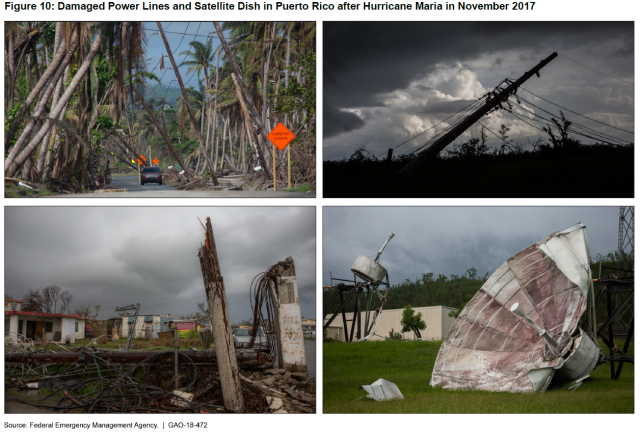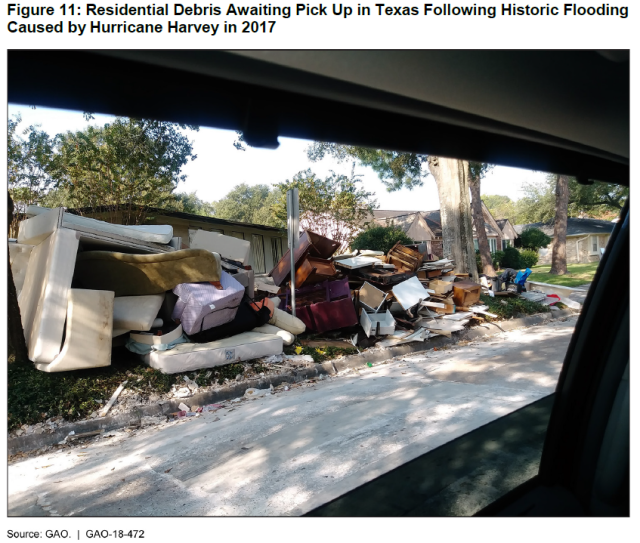2017 Hurricanes and Wildfires
 The timing and scale of the disaster damages nationwide caused shortages in available debris removal contractors and delays in removing debris. Officials in Texas, Florida, Puerto Rico, and California reported challenges with debris removal operations following each disaster in 2017, for example, clearing trees as well as residential, commercial, and construction goods, including hazardous materials.
The timing and scale of the disaster damages nationwide caused shortages in available debris removal contractors and delays in removing debris. Officials in Texas, Florida, Puerto Rico, and California reported challenges with debris removal operations following each disaster in 2017, for example, clearing trees as well as residential, commercial, and construction goods, including hazardous materials.

 In addition, officials struggled to find temporary housing for disaster survivors in each location. For example, FEMA transported survivors in Puerto Rico to the mainland United States to stay in hotels. In Texas, FEMA used new authorities to provide Texas with over $1 billion to manage its own housing program.
In addition, officials struggled to find temporary housing for disaster survivors in each location. For example, FEMA transported survivors in Puerto Rico to the mainland United States to stay in hotels. In Texas, FEMA used new authorities to provide Texas with over $1 billion to manage its own housing program.
 The 2017 disasters overwhelmed FEMA’s workforce. FEMA was not prepared to deploy personnel to four near-simultaneous disasters. We also found that FEMA struggled to both train and retain employees. The figure below shows the total federal disaster workforce deployed to the various disasters in 2017.
The 2017 disasters overwhelmed FEMA’s workforce. FEMA was not prepared to deploy personnel to four near-simultaneous disasters. We also found that FEMA struggled to both train and retain employees. The figure below shows the total federal disaster workforce deployed to the various disasters in 2017.
 Preparing for the 2018 hurricane season
Based on its review of actions taken in response to the 2017 hurricanes, FEMA has taken steps to prepare for the 2018 Atlantic hurricane season. For example, FEMA updated hurricane response plans and procedures for all states and territories. In May 2018, FEMA also conducted a large 2-week training exercise to improve response and initial recovery operations capabilities.
We are conducting a comprehensive review of the federal government’s national preparedness capabilities, training, and funding; we plan to issue that report in the summer of 2019.
To learn more about FEMA’s response and recovery work in 2017, check out the full report.
Preparing for the 2018 hurricane season
Based on its review of actions taken in response to the 2017 hurricanes, FEMA has taken steps to prepare for the 2018 Atlantic hurricane season. For example, FEMA updated hurricane response plans and procedures for all states and territories. In May 2018, FEMA also conducted a large 2-week training exercise to improve response and initial recovery operations capabilities.
We are conducting a comprehensive review of the federal government’s national preparedness capabilities, training, and funding; we plan to issue that report in the summer of 2019.
To learn more about FEMA’s response and recovery work in 2017, check out the full report.
- Questions on the content of this post? Contact Chris Currie at CurrieC@gao.gov.
- Comments on GAO’s WatchBlog? Contact blog@gao.gov.

GAO's mission is to provide Congress with fact-based, nonpartisan information that can help improve federal government performance and ensure accountability for the benefit of the American people. GAO launched its WatchBlog in January, 2014, as part of its continuing effort to reach its audiences—Congress and the American people—where they are currently looking for information.
The blog format allows GAO to provide a little more context about its work than it can offer on its other social media platforms. Posts will tie GAO work to current events and the news; show how GAO’s work is affecting agencies or legislation; highlight reports, testimonies, and issue areas where GAO does work; and provide information about GAO itself, among other things.
Please send any feedback on GAO's WatchBlog to blog@gao.gov.
